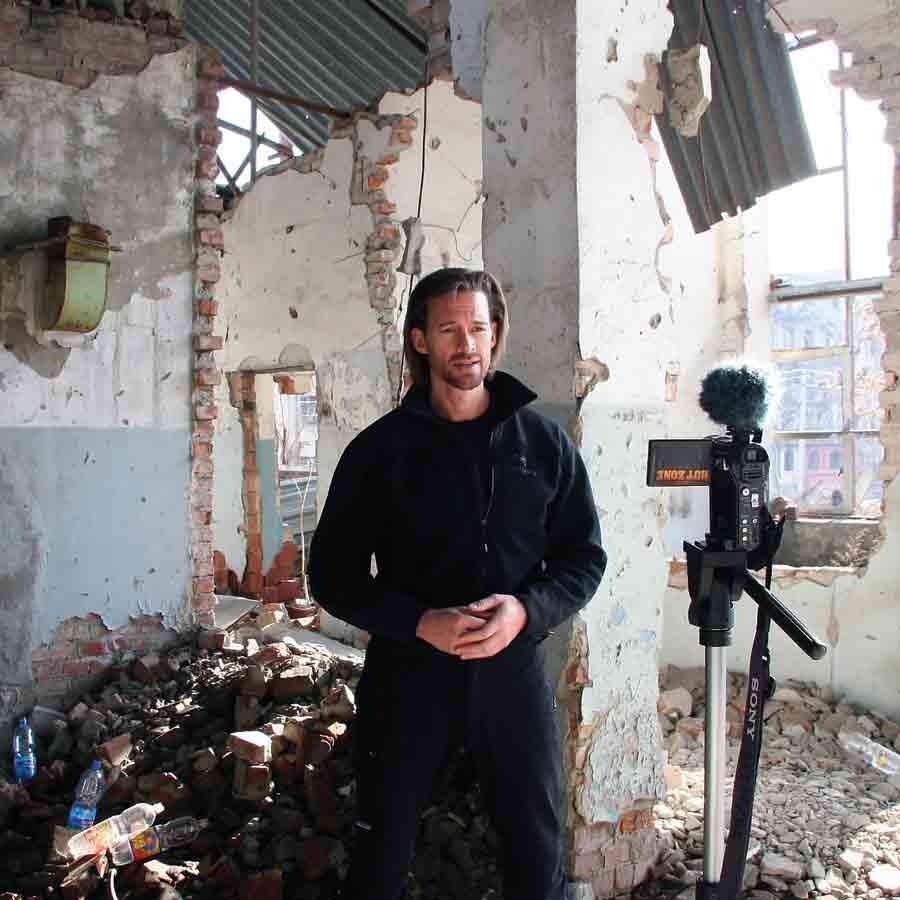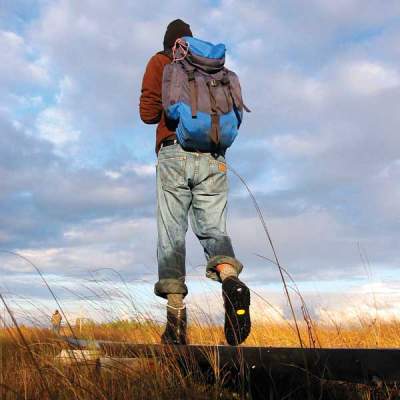Kevin Sites travels light, fast and alone. One of a new breed of 'backpack journalists,' he's midway through a one-year tour of the world's war zones. James Stairs caught up with him during a break in London, England.
It’s war reporting for the plugged-in generation. It’s fast, mobile and to the point. It’s also deadly serious.
It’s the Hot Zone, starring journalist, Kevin Sites, and it’s a story currently unfolding on your computer screen. As the central figure of an ambitious war reporting project, backed by the internet giant Yahoo!, Sites is on schedule to visit and report from every major current conflict in the world for his web site, Kevin Sites in the Hot Zone. What makes the Hot Zone different from traditional news outlets is that Sites is doing it all in one year. He is also travelling alone while he does it and the equipment he uses all fits into his backpack.
“The idea is to entice people to join us on this journey,” Sites says during an interview in Yahoo! Europe’s UK offices where he was recently on a short break from the Hot Zone schedule. “The goal of the project is to put a human face on global conflict,” he says. “If I tell stories from in front of and behind the conflict then people might get interested.” And, he’s betting, they might be interested enough to become part of the solution. There are wars being fought in our names. The point is we have a say.
The project is devoted to clearly identifying who is fighting, why they are fighting, how the war affects ordinary people on the ground and its global implications. It urges those who get interested to continue learning by accessing the links posted on the site to get more information about the regions of the world affected by war.
“That’s the idea—to use the power of the internet as a platform to tell stories that get people involved.”
Sites, 43, began his journey in November of 2005 by covering several major conflicts in Africa. He started in Somalia and then continued on to wars in the Democratic Republic of Congo, Uganda and Sudan. This was followed by several months in the Middle East, covering Lebanon, Iran, Iraq, Syria, Israel and the Palestinian Territories.
“When I go to these conflict zones and meet people from that region and tell their stories, hopefully these reports start to create an idea of the larger picture,” he says.
The Hot Zone project is just another step in Sites’ often controversial career.
“Journalism was my first job,” he smiles.
"You know in your gut when you've seen something wrong. Your mind can be wrong but your instincts are pretty good about those things."
As a teenager, inspired by early war photographers like W. Eugene Smith, Sites put his first camera to use. He assembled a portfolio of pictures (“it was kind of crap,”) and approached the local newspaper in his hometown of Geneva, Ohio for a job. He says that at first, they blew him off, but a few months later he got a call and soon he was riding his bicycle to assignments taking pictures of Cub Scout meetings, society functions and the occasional fire. He was 15 years old.
It was at an anti-abortion rally, one of the contentious issues of the time, that Sites says he started to find his voice as a journalist. At the rally Sites encountered a person who was to make an impact on his career.
“There was this priest who said something that has stayed with me all of my life. He wasn’t all 'fire-and-brimstone, abortion is wrong'. He addressed these people who were waiting for him to spit blood and he said, ‘Are we willing to admit that there are weaknesses in our position? Are we willing to admit that we are wrong in some places?’ So I wrote this down and thought, ‘this is fantastic, it’s not just black and white, there is something that provides all these shades of grey.
“I ended up staying up late and writing a story and I left it on the editor’s desk. The next day I saw it on the front page.” It was then, he says, that he became hooked on reporting.
In the early 1980s, Sites got his first taste of conflict journalism in South America covering the bloody civil war between Nicaragua's left-wing Sandinista government, and the American-backed Contra guerrillas. He admits that he was naïve and unprepared for the dangers of a war zone. Living in a rented car, he earned money writing about international protesters who had flocked to the country during the war.
“I saw a lot of the conflict there. I didn’t quite do it right but I learned a lot.”
Today, Sites works alone in the field. Every bit of equipment he uses has to fit into his backpack. He carries two lightweight video cameras, a laptop computer, a satellite telephone as well as other gadgets designed to keep him small, mobile and inconspicuous.
He files his stories through a satellite phone link-up to his production team back home who edit his material, organize logistics and keep the web site up-to-date. The Hot Zone offers up print articles, video reports, audio reports and photographs. The initial plan also included interactive chat, but so far, they haven't been able to overcome the logistical challenges of setting up an online chat in the middle of a war zone.
The Hot Zone lets Sites break away from the other reporters who have to chase news as it unfolds. He’s not there to give the latest breaking news, he explains, he’s there to show how these events are affecting people on the ground. “The advantage of working alone is that I have greater mobility,” he says. And it leaves what he calls a ‘smaller footprint.’
“When I go in to a place, I draw less attention by myself than I would if I had four people with me. When there’s only one seat on the plane or in the car, it helps.”
Being alone also allows him to be more personal with the people he interviews.
Without a full crew and all their equipment, people will often relax and he can better understand what’s really going on.
Sites admits that working alone also has its downsides, it’s less secure and collaboration is sometimes difficult as the Hot Zone team is back in the United States and they only speak once a day.
While the Hot Zone project is the first of its kind, using internet technology from war zones is nothing new to Sites. As a freelance cameraman during the second Iraq war, he began to blog on top of his regular job. The blog turned out to be a huge hit and was flourishing until it was shut down by CNN, his employer at the time who, he says, feared that he might use it to get political.
It was not his blog however, but the events several months later in the Iraqi city of Fallujah that thrust him fully in to the global spotlight and that indirectly led him to the Hot Zone project.
In November of 2004, Sites was travelling with a group of U.S. Marines as an embedded reporter when the unit he was with entered a mosque during a major offensive on the city. Inside the mosque there were several Iraqi fighters who had been wounded in battle the day before. Sites was filming the scene when an American soldier shot and killed an unarmed and wounded Iraqi fighter. After shooting the man, the soldier turned his back and walked out of the room, seemingly unperturbed by his actions.
“You know how you know in your gut when you’ve seen something wrong?” Sites asks. “Your instincts tell you that. Your mind can be wrong but your instincts are pretty good about those things. When I saw that, I had a sick feeling, not because it was disgusting, but it was like ‘that’s wrong, that’s really wrong. There’s nobody there, there’s no threat whatsoever.”
"A journalist has to show the truth and trust that, in a democracy, if people are given the truth, that they do the right things with it."
Knowing the footage was controversial Sites' first instinct was to take it to military command where it was passed up the ranks. No one, he said, ever tried to stop him from releasing the tape. The American networks showed only a heavily edited version of the footage in their reports, claiming that the content was too graphic.
“We practiced self-censorship on this one, and the whole story of what happened that day didn’t get out,” he says.
When the unedited video did find its way to the public via the internet and through Arabic-language networks, a firestorm of controversy erupted. The tape caused outrage among many - the shooting seen as a breach of the war’s rules of engagement.
Supporters of the war blamed Sites for the controversy, claiming that the images would both embolden the Iraqi resistance and weaken public support for the war by discrediting the soldiers on the ground.
Sites’ blog was besieged with accusations that he was an anti-war activist and that he was furthering his own career by releasing the footage. NBC, his employer at the time, distanced itself from him and the controversy. Isolated and inundated with questions and accusations, Sites went in to hiding and soon left Iraq, quite sure he would never return.
Today, Sites has come to terms with the events of Fallujah and seems to be determined to apply the lessons he learned.
“I had to spend the next year of my life trying to defend my actions as a journalist and at the same time educate people about what really happened in that mosque,” he says. “I argued initially to not show the video because it was too hot, too crazy at the moment—the logic being that the insurgents would never surrender if they knew that they would be executed and that there was the possibility of retribution.”
He says he never heard any complaints from active soldiers about the incident but he was concerned about what they might have heard and was determined to clear the air. True to form, he used his blog to write an open letter to the marines to tell his side of the story.
Several months later, the experience would help form one of the core principles behind the Hot Zone project: Limit self-censorship. Just like the priest at the rally in his hometown who illuminated the shades of grey that exist in every story, the Fallujah incident taught Sites that his job is to give people the facts, what they do with them is their choice.
“Anywhere, not just in conflict, a journalist has to show the truth and trust that, in a democracy, if people are given the truth, that they do the right things with it,” he says.
When he left Iraq, Sites went to Thailand to scuba dive and clear his mind. He was in the region when the Boxing Day tsunami hit and, even though he was still coming to grips with his experiences in Iraq, he went back to work.
After filing several reports covering the impact of the tsunami, Sites returned to the U.S. and, determined not to return to Iraq, began looking around for other options. A family friend approached him about working for Yahoo! and the idea for the Hot Zone was born.
“They didn’t come to me and say ‘do conflict zones’, I suggested that because that is how people know me and it is something I feel needs coverage well beyond the way we’re doing it now. We need to put a human face on it; it can’t just be just body counts.”
Living on the road and travelling to dangerous places takes stamina and sensitivity.
“The best travellers I know are flexible,” he says. “They adjust well to their surroundings. If you go to a place and want to apply your own cultural standards, you’ll be sorely disappointed. “You have to let people take you places.”
Halfway through its grueling schedule, the Hot Zone has a loyal following and is getting close to a million hits a week. Most recently, Sites spent time in Chechnya and is now in Afghanistan. He will then travel to Colombia and Latin America with a possible stop in Haiti before crossing the globe again to report on several Asian conflicts including Indonesia, the Philippines and the Korean peninsula.
The project is scheduled to wrap up, on schedule, in November and Sites and his production team are already thinking ahead. There are plans for Hot Zone America, where Sites will travel around his native country, looking for stories that are just off the radar of traditional newsgathering outlets.
He’s even considering doing it in a bus, just to get people interested.
Follow Kevin Sites' Journey Here
Add this article to your reading list




